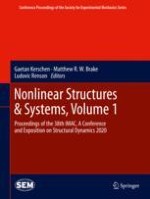2021 | Book
Nonlinear Structures & Systems, Volume 1
Proceedings of the 38th IMAC, A Conference and Exposition on Structural Dynamics 2020
Editors: Prof. Gaetan Kerschen, Dr. Matthew R.W. Brake, Dr. Ludovic Renson
Publisher: Springer International Publishing
Book Series : Conference Proceedings of the Society for Experimental Mechanics Series
